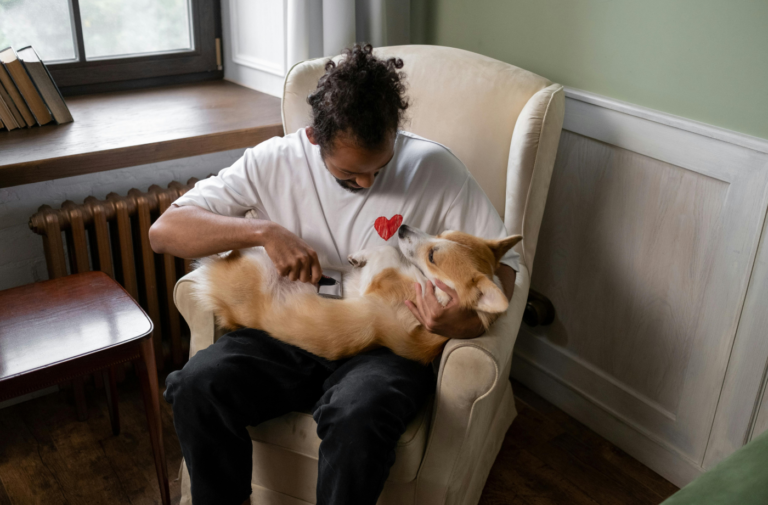Training your dog can be one of the most rewarding experiences as a pet owner, but it often comes with challenges. When training a dog with a shock collar, it’s essential to use it responsibly. Shock collars can be an effective tool for addressing behavioral issues and teaching commands. However, it’s necessary to approach this method cautiously, incorporating positive reinforcement and focusing on your pet’s well-being throughout the process.
Understanding the Basics of Shock Collars
Shock collars, also known as e-collars or electronic collars, are devices designed to aid in training and behavioral correction. They are widely used to address specific behaviors, but it’s crucial to understand how they work and their proper use.
What is a Shock Collar?
A shock collar consists of two main components: a collar-mounted receiver and a handheld remote. The receiver delivers stimulation, triggered by the remote, to reinforce desired behavior or discourage unwanted actions. Stimulation levels vary and can include a beep, vibration, or electrical pulse, allowing you to customize the training experience to your dog’s needs.
Check out this dog shock collar training guide to learn more about the design and functionality of shock collars.
Types of Stimulation Settings
Shock collars come with three modes: shock, vibration, and beep. Here’s what each setting does:
- Beep: Acts as a warning signal or marker, often paired with verbal commands.
- Vibration: Provides a gentler nudge to grab the dog’s attention.
- Shock: Offers an adjustable level of correction, used as a last resort for reinforcing behavior.
It’s best to start with the lowest setting and work up gradually based on your dog’s reaction. For a more humane approach to using shock collars, explore this source on training with e-collars.
Choosing a Quality Shock Collar
Investing in a high-quality shock collar ensures safety and effectiveness. Here are key factors to consider:
- Adjustable Intensity: Essential for customizing to your dog’s sensitivity.
- Range: Consider where training will occur (e.g., backyard vs. open field).
- Battery Life: Opt for a collar with long-lasting and rechargeable batteries.
- Built-in Safety Features: Some collars have automatic shutoffs to prevent overuse.
Modern collars, like those offered by E-Collar Technologies, include features like tone options and GPS trackers for added functionality.

Photo by RDNE Stock project.
Preparing for Shock Collar Training
Preparation is vital before you begin using a shock collar. Taking a few preliminary steps can help ease your dog into the process.
Acclimating Your Dog to the Collar
Start by introducing the collar without activating it. Let your dog wear it for several days to get used to the sensation. Keep the collar turned off during this acclimation period to avoid unnecessary stress.
Ensuring a Proper Fit
Fitment is critical to avoid discomfort or skin damage. The collar should sit firmly around the dog’s neck but not so tight that it restricts movement or breathing. Position the receiver’s contact points on the underside of your dog’s neck for optimal functionality.
Determining Your Dog’s Sensitivity Threshold
Each dog responds differently to stimulation. Start at the lowest level of intensity and gradually increase until you observe a subtle response, such as a twitch or alert behavior. Always aim for the mildest level that gets your dog’s attention. For additional tips, look into this step-by-step guide.
Training Techniques Using a Shock Collar
How to train a dog with a shock collar: Effectively using a shock collar involves pairing it with structured training techniques and positive reinforcement.
Pairing Commands with Stimulation
Before activating the collar, introduce verbal commands like “sit” or “stay.” Pair the command with the appropriate stimulation level, giving your dog a clear association between the two. Over time, the goal is for your pet to respond to the command alone, without stimulation.
Positive Reinforcement and Rewards
Shock collar training should always include rewards to encourage good behavior. Treats, praise, or playtime should be used whenever your dog responds correctly. Positive reinforcement helps build trust and reinforces the behavior you want to see.
Avoiding Common Mistakes
Some common pitfalls include:
- Overusing the Collar: Training sessions should be limited to short intervals to avoid stress.
- Using Excessive Intensity: Always start at the lowest setting.
- Poor Timing: Deliver stimulation immediately so your dog associates it with their behavior.
When and When Not to Use a Shock Collar
Shock collars aren’t suitable for every dog or every situation. They should never replace humane training practices. Here’s how to decide when they’re appropriate:
Recognizing Signs of Stress in Your Dog
Pay attention to body language. Signs of stress, like excessive panting, tail tucking, or avoiding eye contact, may indicate that the collar is causing harm. If this happens, reduce intensity or seek alternative methods.
Professional Guidance for Advanced Training
When training stalls or escalates behavior, consult a professional trainer. Certified trainers can offer tailored techniques and ensure the collar is used correctly and safely. You can explore more detailed instructions on advanced shock collar use on Ruby and Thunder’s website.
Conclusion
Shock collars can be a helpful tool if used wisely and responsibly. Always approach training with your dog’s well-being in mind, combining positive reinforcement and gentle corrections. By understanding proper techniques, avoiding mistakes, and recognizing when professional help is needed, you can achieve lasting results that strengthen your bond with your dog. When in doubt, prioritize gentle alternatives, and remember that patience is key to training success.














